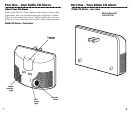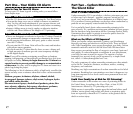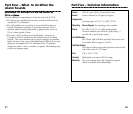
16
15
Part One – Your Kidde CO Alarm
How to Know If Your Alarm is Malfunctioning
Your CO alarm performs an internal self-diagnosis every fifteen sec-
onds to make sure that it is functioning properly. The CO alarm is
designed to alert you in the unusual event of a malfunction.
If the alarm malfunctions.
In the rare event that your alarm malfunctions, it will alert you with
one of these signal groups (depending upon the type of malfunction
that occurs):
Malfunction Signal Group 1 - Component Failure
– An intermittent “chirping” alarm will sound every 30 seconds.
OR,
Malfunction Signal Group 2 - Microprocessor Failure
– The alarm will sound continuously, and
– The alarm cannot be shut off by pushing the “Test/Reset” button
Unplug the CO alarm immediately and return for warranty exchange
(see “Warranty” on page 34).
What to do if you’re not sure...
PLEASE familiarize yourself with the malfunction alert, and do not con-
fuse these signals with an alarm. After reading the information above, if
you are still unsure whether your CO alarm is operating properly, call
the Kidde toll-free consumer hotline at 1 800-581-6742 to do a quick
diagnostic check of the alarm over the phone. The customer service
representative will be able to assist you and answer your
questions.
If your CO alarm sounder is beeping, and you are not sure if it is a CO
alarm or a malfunction alert, reset the alarm, open windows for ventila-
tion, turn off fuel-burning appliances (like kerosene or oil heaters, fur-
naces, gas ranges, wood-burning stoves, water heaters, or other fossil-
fuel burning appliances). For furnaces, you can simply turn down the
thermostat to its lowest setting. Open windows and doors for ventila-
tion. Then call the Kidde toll-free consumer hotline at 1 800-581-6742
for assistance.
Before you call a qualified technician (such as a licensed heating con-
tractor, utility service technician, chimney sweep or fuel provider) to
check your residence for CO, remember that you will probably be
charged for a service call. Kidde customer service operators are avail-
able to answer your questions and assist you in non-emergency situa-
tions at no charge.
Never ignore a CO unit’s alarm. A true alarm is an indication of poten-
tially dangerous levels of carbon monoxide. CO alarms are designed to
alert you to the presence of carbon monoxide before an emergency,
before most people would experience symptoms of carbon monoxide
poisoning, giving you time to resolve the problem calmly.
Part One – Your Kidde CO Alarm
Testing the Electronics
You should test the alarm once a week, following the directions
listed below. If at any time you test the alarm and it does not per-
form as described below, have it replaced immediately. Turn to page
16 “How to know if your alarm is malfunctioning” for a description
of the characteristics of a malfunctioning alarm and what you should
do if a malfunction occurs.
Observe the CO alarm regularly to make sure the green operate light
is on, indicating normal operation.
If the green operate light is not on, unplug the CO alarm for three
minutes, then plug in again. This will clear the alarm for restart.
If the green operate light does not come back on, your CO alarm
may be malfunctioning.
To test the CO alarm, press and release the Test/Reset button,
within 15 seconds if the CO alarm is operating properly, you will
hear 4 quick beeps – followed by 5 seconds of silence – followed by
4 quick beeps. Notice the Red Alarm Light flashes when the unit
alarms.
When you test the CO alarm, we advise you to place your finger
over the sounder opening in the front of the CO alarm.
Within a minute, the alarm will then return to monitoring for carbon
monoxide.
NOTE: Pressing the Test/Reset button tests the functions of the
CO alarm’s internal components, circuitry and micro-computer.
YOU DO NOT NEED TO PRESS THE TEST BUTTON TO TAKE
A CO READING.


















